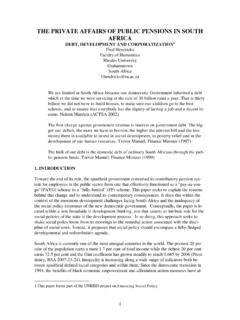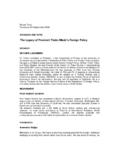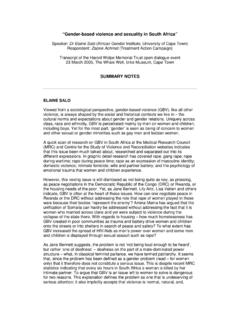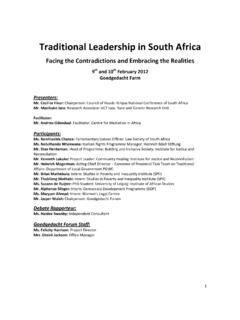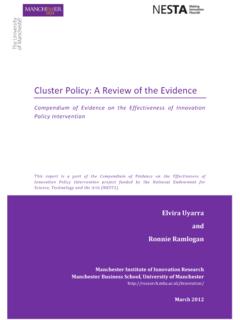Transcription of A South African developmental State: What is …
1 A South African developmental State: what is possible ? by Stephen Gelb (The Edge Institute and University of the Witwatersrand) Paper presented at the Harold Wolpe Memorial Trust s Tenth Anniversary Colloquium, Engaging silences and unresolved issues in the political economy of South Africa , 21-23 September 2006, Cape Town, South Africa DRAFT: NOT TO BE QUOTED WITHOUT THE AUTHOR S PERMISSION The Accelerated and Shared Growth Initiative for South Africa (ASGI-SA) economic policy framework announced by the government in late 2005 has confirmed the return into policy discourse of the role of the state, as compared with the mid-1990s. The focus on state spending on infrastructure and skills development, and the selection of priority sectors both signify a central role for the state in the economy. The government has backed off from its earlier focus on privatisation of the SOEs. There are also indications that the state is willing to take on individual firms, in the examination of a windfall tax for SASOL and the imposition on retailers of quotas on Chinese textile imports.
2 But does this mean that the South African state is a developmental state ? Can we be confident that returning the state to its rightful place at the centre of the policy framework will lead to desired outcomes with respect to growth and development? To answer these questions, we need to begin by reflecting on what is meant by a developmental state . 1. The developmental state some comparative reflections It is appropriate to begin with some general characteristics of a developmental state. Such a state is able to carry out four key tasks: (i) to formulate a cohesive and focussed set of goals and objectives for national growth and development, and a set of policies to achieve these goals; (ii) to co-ordinate the mobilisation and allocation of (financial and human) resources for investment in line with the policies identified; (iii) to monitor and evaluate progress towards the objectives as a result of the policies; and (iv) to adjust the mobilisation and allocation of resources in response to progress made towards existing objectives, changes in objectives and exogenous pressures and shocks.
3 Fulfilling these tasks requires a significant degree of centralised direction of resource flows, but getting the balance right is difficult if centralisation goes too far, there is a A South African developmental State: what is possible ? (Stephen Gelb) 2risk that national development objectives will be overwhelmed by and replaced with the particularistic aims of the central authority; if centralisation does not go far enough, the private benefits of individual dispersed agents especially those who own and control resources - may dominate broader social or national objectives. what kind of state is capable of achieving this balance? In an economy with private, decentralised ownership of capital for production, the major problem confronting the developmental state is its relations with the owners of capital, business. A developmental state has the ability to direct firms in their investment and innovation activities, supporting and subsidising their movement into activities which will advance national objectives.
4 But at the same time, the third and fourth tasks above monitoring and adjusting resource allocations in response to progress and changes in the environment mean that the developmental state not only sets performance targets for firms, but can impose discipline on firms by withdrawing support from firms which do not meet their targets. In other words, the developmental state incorporates what Alice Amsden called a control mechanism . (2001) A key characteristic of a successful developmental state is its ability to provide leadership in resolving collective action problems which will inevitably arise in defining and addressing commonly agreed goals. (Bardhan, JEP, 1993) Such leadership can be understood in terms of the formulation of a successful growth model , a policy framework which synthesizes the interests of different groups to achieve growth, in which the synthesis reflects a growth and distribution bargain defining both the contributions to sustained growth and the respective shared of the gains from growth amongst those groups incorporated in the model s framework.
5 For example, Keynesianism used aggregate demand management policies to support domestic market growth, raising profits for firms and wages and living standards for workers together and emphasising the co-operative dimension of the two groups interaction. The interests of the same groups might conflict in a different framework, as for example in the fixed exchange rate gold standard system where relations between firms and workers were conflictual. Implicit in this approach is the idea that economic policy debate is a political process in which groups interests are (re-) constituted (Hall, 1997; Gourevitch, 1989). Most early analysis of the developmental state, inspired by examination of the successful developers in East Asia, focussed on the state s own characteristics, arguing in particular that the state needed to have the ability to act as a corporate entity, that is, be an independent social actor with a single unified set of goals.
6 This work identified a range of characteristics of the bureaucracy as necessary conditions for a developmental state meritocratic recruitment, professional norms and ethos, esprit de corps, and so on. From this statist perspective, the state s relationship with society could be summarised in Peter Evans justly famous label embedded autonomy : embeddedness reflecting the state s intensive interaction with society (especially business) to enable flows of information and resources in both directions, in the process of policy formulation, implementation and monitoring; autonomy reflecting the state s ability to act independently and non-arbitrarily by withdrawing support from individual firms which failed to meet performance targets. More recent work on the developmental state (Chibber, Kohli) has argued that this view assumed too easily that the states in successful East Asian developers were able to simply dominate their business classes, which, it was taken for granted, were undeveloped and weak relative to their national states .
7 This work questions whether state dominance over business was any greater in economies such as Korea or Taiwan than elsewhere, and on this basis rejects the argument that it is state Harold Wolpe Memorial Trust colloquium, September 2006, Cape Town, South Africa 3dominance over business as a class which is the critical factor determining why some states achieved success as developmental states , and others did not. This view, located in a state-in-society perspective (Migdal), understands the East Asian states to have had more modest levels of power within their societies, similarly to other states in Asia and Africa. Yet the East Asians nonetheless emerged as successful developmental states because the business classes in their societies acquiesced in and supported both the economic development model national objectives and policies put forward by the state, and, importantly, also acquiesced in the state s disciplining of individual firms.
8 This view argues that a developmental state emerges in the course of rapid growth and development, that is, in the context of a successful growth model, rather than existing as a developmental state prior to rapid development. Furthermore, the developmental state reflects inter alia an co-operative relationship between the state and business, that is, it emerges with the acceptance and collaboration of business, in the sense that business as a class engages with the model of development, reflected in sustained high levels of business confidence. Thus the developmental state is able to dominate individual firms within business, but not the totality of business. In other words, the developmental state rests on a virtuous circle of growth, profitability and investment implicit in the model itself. This does not mean that a developmental state focuses only on the state-business relation other classes, including labour, can be incorporated into the growth model.
9 Indeed, the successful East Asian developers were characterised by high levels of income distributional equality, both prior to and during their growth accelerations, and the process of shared growth was crucial to their success (Campos & Root). 2. The state in post-apartheid South Africa This argument has been elaborated primarily in the context of explaining the relative failure of the post-colonial Indian state, a state with clear developmental aspirations, to meet its objectives. But resting on the idea that the state has relatively modest power vis- -vis the business class, it is appealing as a starting point for examining the state in post-apartheid South Africa. At the time of the democratic transition, the South African state was weak in that it had limited ability to organise and exercise power for the centralized, institutionalized, territorialized regulation of many aspects of social relations (Mann, 1993).
10 This is true by definition because the state was unable to prevent the transition from apartheid authoritarianism to non-racial democracy. At the height of its power, in the 1970s, the apartheid state had had substantial infrastructural power in relation to white and black populations, the power to penetrate and centrally co-ordinate the activities of civil society , which depends on organisational, institutional and administrative infrastructure (Gelb, 2001). Though able to avoid being overthrown and force a negotiated transition, the apartheid state s authority - its ability make decisions binding on the population became attenuated through the 1980s, as it proved unable to establish infrastructural power vis- -vis the new forms of black social organisation which had emerged from the late 1970s. The new democratic state inherited the structures of the old, and state weakness at the point of transition was reflected in difficulties in regulating behaviour of individual citizens and in carrying out many of its basic functions including policing, border control and taxation.
